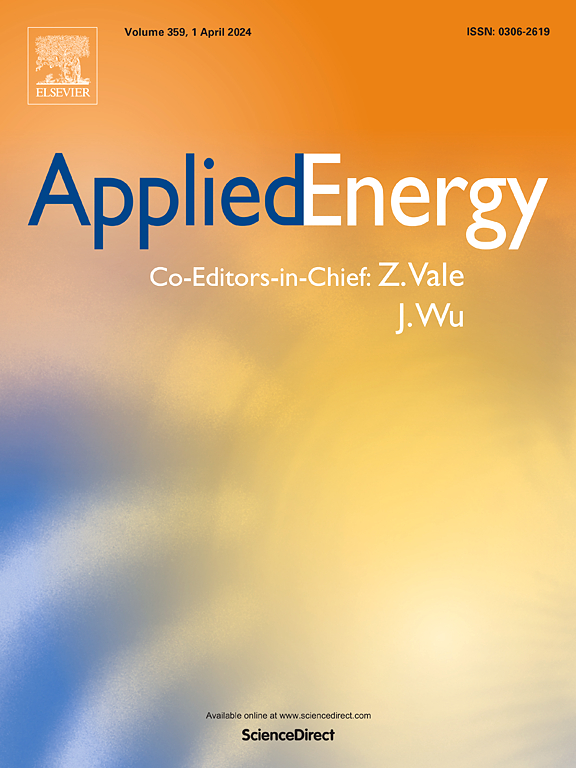通过Stackelberg游戏同步柔性负荷与风能,实现可再生能源整合和经济效率
IF 10.1
1区 工程技术
Q1 ENERGY & FUELS
引用次数: 0
摘要
现代电网通过需求响应(DR)整合电动汽车(ev)和电池储能系统(BESS)等灵活负载,使产消者能够参与能源管理。然而,主要的挑战在于激励电动汽车车主调整他们的低成本充电计划,以适应分布式发电,例如风能和光伏发电(PV)。这就需要一个比客户最初计划的储蓄更具吸引力的经济激励机制。从数学的角度来看,主要的挑战在于找到问题的对偶,因为在电动汽车和BESS的建模中存在几个不相交或重叠的基于时间的异常。本研究旨在通过基于激励的DR框架优化光伏、风能和灵活电动汽车负载之间的协同作用。提出了一种双层模型,并利用Stackelberg博弈在风电场集成商和客户之间求解,降低了客户成本,改善了风负荷匹配。提出的双层模型通过双重公式转换为单层等效模型,解决了重叠的基于时间的异常导致冗余的复杂性。经过季节验证,结果突出了DR在增强聚合器和客户结果方面的成功。在一个示例案例中,客户的能源成本下降了高达146.56欧元/天,聚合器在一天内减少了高达356 千瓦时的风能负载不匹配。结果表明,更大的负载灵活性和风电容量可以提高经济和能源管理成果,突出了可扩展DR机会的影响。本文章由计算机程序翻译,如有差异,请以英文原文为准。
Synchronizing flexible loads with wind energy via Stackelberg game for renewable integration and economic efficiency
The modern electric grid enables prosumers’ participation in energy management by integrating flexible loads like electric vehicles (EVs) and battery energy storage systems (BESS) via demand response (DR). However, the main challenge lies in motivating EV owners to adjust their low-cost charging plans to align with distributed generation, e.g., wind and photovoltaic (PV) power. This requires a reward system with more attractive financial incentives than the customers’ initially planned savings. From the mathematical standpoint, the primary challenge lies in finding the dual of the problem due to the presence of several disjoint or overlapping time-based exceptions in the modeling of EVs and BESS. This study aims to optimize the synergy between PV, wind, and flexible EV loads via an incentive-based DR framework. A bi-level model is proposed and solved using a Stackelberg game between a wind-farm aggregator and customers, reducing customer costs and improving wind-load matching. The proposed bi-level model is transformed into a single-level equivalent through a dual formulation, addressing the complexities of overlapping time-based exceptions causing redundancies. Validated across seasons, the results highlight the DR’s success in enhancing aggregator and customer outcomes. In an example case, customer energy costs dropped by up to 146.56 €/day, and the aggregator reduced the wind energy-load mismatch by up to 356 kWh in one day. Results show that greater load flexibility and wind capacity enhance economic and energy management outcomes, highlighting the impact of scalable DR opportunities.
求助全文
通过发布文献求助,成功后即可免费获取论文全文。
去求助
来源期刊

Applied Energy
工程技术-工程:化工
CiteScore
21.20
自引率
10.70%
发文量
1830
审稿时长
41 days
期刊介绍:
Applied Energy serves as a platform for sharing innovations, research, development, and demonstrations in energy conversion, conservation, and sustainable energy systems. The journal covers topics such as optimal energy resource use, environmental pollutant mitigation, and energy process analysis. It welcomes original papers, review articles, technical notes, and letters to the editor. Authors are encouraged to submit manuscripts that bridge the gap between research, development, and implementation. The journal addresses a wide spectrum of topics, including fossil and renewable energy technologies, energy economics, and environmental impacts. Applied Energy also explores modeling and forecasting, conservation strategies, and the social and economic implications of energy policies, including climate change mitigation. It is complemented by the open-access journal Advances in Applied Energy.
 求助内容:
求助内容: 应助结果提醒方式:
应助结果提醒方式:


